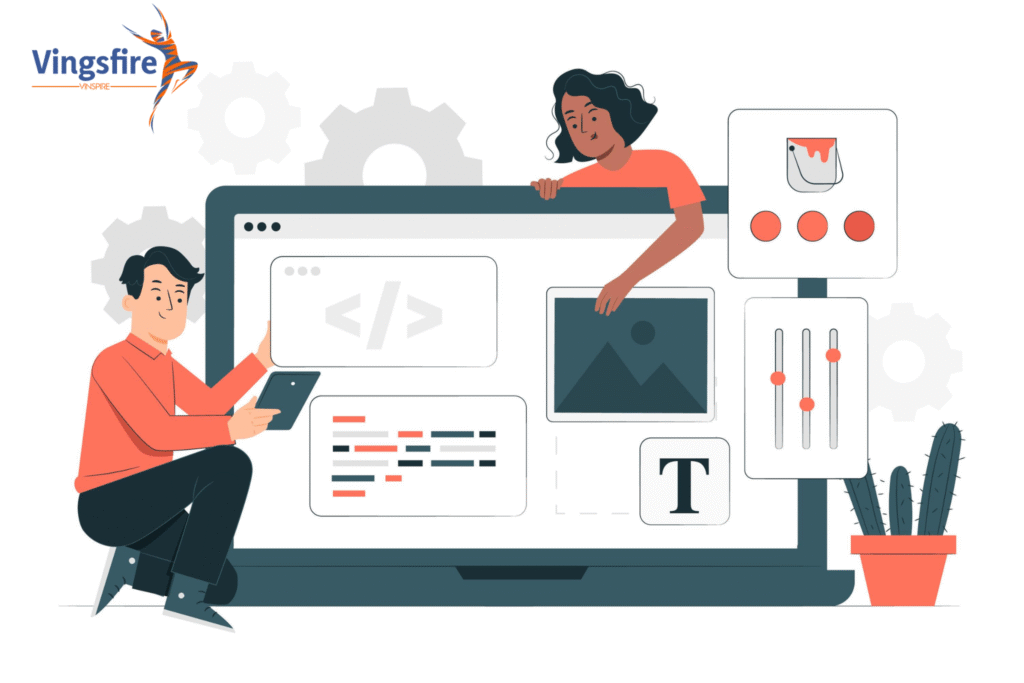
In today’s digital-first world, frontend development has evolved from simply creating static web pages to building immersive, interactive experiences that captivate users. As the bridge between design and technology, frontend development directly impacts user engagement, conversion rates, and brand perception.
This comprehensive 2,000-word guide will explore everything you need to know about modern frontend development, including:
- Core technologies and frameworks
- Emerging trends shaping 2025
- Best practices for optimal performance
- How Vingsfire delivers exceptional frontend solutions
Section 1: Understanding Frontend Development
What is Frontend Development?
UI Development refers to the practice of creating the visual and interactive elements of a website or web application that users directly interact with. Unlike backend development which handles server-side operations, UI Development focuses on:
- User interface (UI) implementation
- User experience (UX) optimization
- Client-side functionality
- Browser compatibility
Core Technologies in Frontend Development
Every Visual Layer Development professional works with three foundational technologies:
- HTML5: The structural backbone of all web content
- CSS3: For styling and visual presentation
- JavaScript: Enables interactivity and dynamic content
Modern frontend development has expanded to include advanced frameworks, preprocessors, and build tools that enhance productivity and capabilities.
Section 2: Modern Frontend Development Frameworks
1. React.js
Developed by Facebook, React remains the most popular choice for User Interface Engineering due to its component-based architecture and virtual DOM.
Key Features:
- Reusable components
- Strong community support
- Excellent for single-page applications (SPAs)
2. Angular
Google’s full-fledged framework offers powerful tools for enterprise-level Frontend Engineering.
Key Features:
- Two-way data binding
- Dependency injection
- TypeScript-based
3. Vue.js
The progressive framework gaining rapid adoption for its simplicity and flexibility in Interactive UI Solutions
Key Features:
- Gradual adoptability
- Lightweight
- Detailed documentation
4. Svelte
The newcomer challenging traditional Interactive UI Solutions paradigms by shifting work to compile time.
Key Features:
- No virtual DOM
- Truly reactive
- Smaller bundle sizes
Section 3: Essential Frontend Development Tools
Professional Interactive UI Solutions workflows incorporate various tools:
Code Editors & IDEs
- VS Code (Most popular)
- WebStorm
- Sublime Text
Version Control
- Git with GitHub/GitLab/Bitbucket
Package Managers
- npm
- Yarn
- pnpm
Build Tools
- Webpack
- Vite
- Parcel
CSS Tools
- Sass/SCSS
- Tailwind CSS
- CSS Modules
Section 4: Frontend Development Trends for 2025
1. Jamstack Architecture
Modern frontend development increasingly adopts Jamstack (JavaScript, APIs, Markup) for better performance and security.
2. Micro Frontends
Breaking large applications into smaller, independent User Interface Engineering modules.
3. Web Components
Creating reusable custom elements that work across frameworks.
4. Progressive Web Apps (PWAs)
Blurring lines between web and mobile apps through User Interface Engineering techniques.
5. Motion UI
Advanced animations and transitions becoming standard in Web Interface Development
6. Accessibility-First Development
Building inclusive interfaces from the ground up.
7. Dark Mode Implementation
System-level dark theme support in Web Interface Development.
8. WebAssembly (Wasm)
Enabling near-native performance for web applications.
Section 5: Best Practices in Frontend Development
1. Performance Optimization
- Code splitting
- Lazy loading
- Image optimization
- Minification
2. Responsive Design
- Mobile-first approach
- Flexible grids
- Media queries
3. Cross-Browser Compatibility
- Feature detection
- Polyfills
- Progressive enhancement
4. Security Considerations
- Content Security Policy (CSP)
- Input validation
- XSS protection
5. SEO-Friendly Markup
- Semantic HTML
- Structured data
- Performance metrics
Section 6: The Future of Frontend Development
Emerging technologies shaping UI/UX Frontend Services:
1. AI-Assisted Development
- GitHub Copilot
- ChatGPT integration
- Automated testing
2. Web3 Integration
- Blockchain interfaces
- Crypto wallet connections
- NFT displays
3. 3D and AR Experiences
- Three.js
- WebXR
- Augmented reality elements
4. Edge Computing
- Faster content delivery
- Reduced latency
- Distributed processing
Section 7: Why Choose Vingsfire for Frontend Development?
At Vingsfire, we specialize in cutting-edge UI/UX Frontend Services that delivers:
- Pixel-Perfect Implementations: Flawless translation of designs to code
- Blazing Fast Performance: Optimized for Core Web Vitals
- Future-Proof Architecture: Scalable, maintainable codebases
- Cross-Platform Consistency: Seamless experiences across devices
- Progressive Enhancement: Accessible to all users
Our User-Facing Web Development process includes:
- Comprehensive technical planning
- Component-driven development
- Rigorous testing protocols
- Performance benchmarking
- Ongoing optimization
Conclusion: Elevate Your Digital Presence with Expert Frontend Development
User-Facing Web Development has become one of the most critical aspects of digital product creation, directly impacting user satisfaction, conversion rates, and business success. As technologies evolve, staying current with Interactive UI Solutions best practices and trends becomes essential for creating competitive web experiences.
Whether you’re building a new application or modernizing an existing one, investing in professional Visual Layer Development services pays dividends in user engagement and business growth. At Vingsfire, we combine technical expertise with creative problem-solving to deliver exceptional frontend solutions tailored to your specific needs.
Ready to transform your digital presence? Contact our frontend development team today for a consultation.
